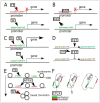DNA Methylation and Histone Modification in Low-Grade Gliomas: Current Understanding and Potential Clinical Targets
- PMID: 36831683
- PMCID: PMC9954183
- DOI: 10.3390/cancers15041342
DNA Methylation and Histone Modification in Low-Grade Gliomas: Current Understanding and Potential Clinical Targets
Abstract
Gliomas, the most common type of malignant primary brain tumor, were conventionally classified through WHO Grades I-IV (now 1-4), with low-grade gliomas being entities belonging to Grades 1 or 2. While the focus of the WHO Classification for Central Nervous System (CNS) tumors had historically been on histopathological attributes, the recently released fifth edition of the classification (WHO CNS5) characterizes brain tumors, including gliomas, using an integration of histological and molecular features, including their epigenetic changes such as histone methylation, DNA methylation, and histone acetylation, which are increasingly being used for the classification of low-grade gliomas. This review describes the current understanding of the role of DNA methylation, demethylation, and histone modification in pathogenesis, clinical behavior, and outcomes of brain tumors, in particular of low-grade gliomas. The review also highlights potential diagnostic and/or therapeutic targets in associated cellular biomolecules, structures, and processes. Targeting of MGMT promoter methylation, TET-hTDG-BER pathway, association of G-CIMP with key gene mutations, PARP inhibition, IDH and 2-HG-associated processes, TERT mutation and ARL9-associated pathways, DNA Methyltransferase (DNMT) inhibition, Histone Deacetylase (HDAC) inhibition, BET inhibition, CpG site DNA methylation signatures, along with others, present exciting avenues for translational research. This review also summarizes the current clinical trial landscape associated with the therapeutic utility of epigenetics in low-grade gliomas. Much of the evidence currently remains restricted to preclinical studies, warranting further investigation to demonstrate true clinical utility.
Keywords: ATRX; CpG island; DNMT; G-CIMP; H3K27M; MGMT; histone acetylation; methylation; methylomics; methyltransferases; tumor suppressor.
Conflict of interest statement
Rupesh Kotecha: Personal fees from Accuray Inc., Elekta AB, ViewRay Inc., Novocure Inc., Elsevier Inc., Brainlab, Kazia Therapeutics, Castle Biosciences, and institutional research funding from Medtronic Inc., Blue Earth Diagnostics Ltd., Novocure Inc., GT Medical Technologies, AstraZeneca, Exelixis, ViewRay Inc., Brainlab, Cantex Pharmaceuticals, and Kazia Therapeutics. Manmeet Singh Ahluwalia: Grants from AstraZeneca, BMS, Bayer, Incyte, Pharmacyclics, Novocure, MimiVax, Merck. Consultation fees from Bayer, Novocure, Kiyatec, Insightec, GSK, Xoft, Nuvation, Cellularity, SDP Oncology, Apollomics, Prelude, Janssen, Tocagen, Voyager Therapeutics, Viewray, Caris Lifesciences, Pyramid Biosciences, Varian Medical Systems, Cairn Therapeutics, Anheart Therapeutics, Theraguix. Scientific Advisory Board membership of Cairn Therapeutics, Pyramid Biosciences, Modifi Biosciences, Guardian Research Network. Stock shareholder of MimiVax, Cytodyn, MedInnovate Advisors LLC, The rest of the authors declare no conflict of interest relevant to the manuscript.
Figures






References
-
- Louis D.N., Perry A., Wesseling P., Brat D.J., Cree I.A., Figarella-Branger D., Hawkins C., Ng H.K., Pfister S.M., Reifenberger G., et al. The 2021 WHO Classification of Tumors of the Central Nervous System: A summary. Neuro Oncol. 2021;23:1231–1251. doi: 10.1093/neuonc/noab106. - DOI - PMC - PubMed
Publication types
LinkOut - more resources
Full Text Sources
Research Materials

